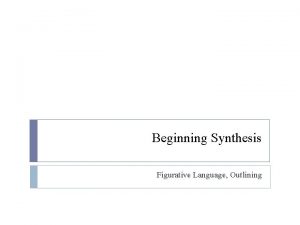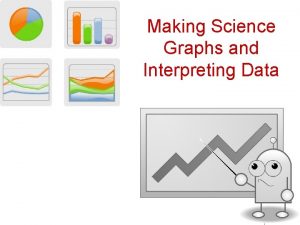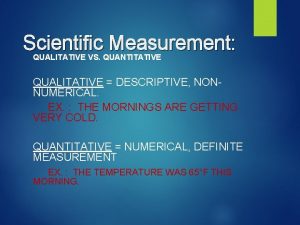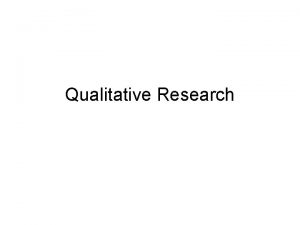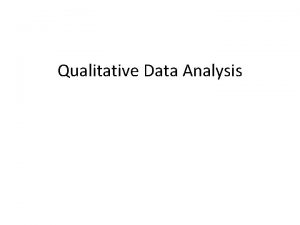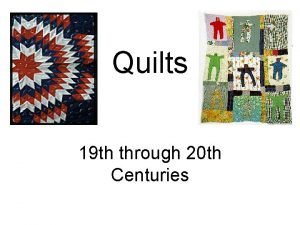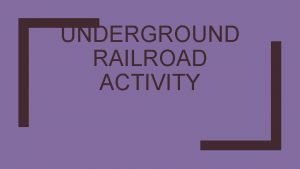Making Quilts The Art and Science of Qualitative

































- Slides: 33

Making Quilts: The Art and Science of Qualitative Research Andrew Sussman, Ph. D, MCRP Family and Community Medicine 1. 25. 14

Overview Ø Qualitative Research: what, why, how Ø Mixed Method Research Ø See one, do one “Life is not a problem to be solved, but a reality to be experienced. ” —Soren Kierkegaard

Making Quilts Ø Bricoleur— "make creative and resourceful use of whatever materials are at hand”

Situating Qualitative Research Ø Qualitative/quantitative research are not just different ways of doing research, but different ways of knowing Ø Paradigm: a pattern or model (Thomas Kuhn): methods often highlighted but are downstream l l Ø (Post) Positivism Interpretivism Science as “cultural filter” “What we observe is not nature itself, but nature exposed to our method of questioning. “ —Werner Heisenberg

What is qualitative research? Quantitative Research (Positivism) ØMeasurement-numbers Ø“Top down” ØGeneralizing ØObjective ØSeparating and reducing Qualitative Research (Interpretivism) ØContext, values, experiences Ø“bottom up” ØSubjectivity ØSeeing the whole picture ØParticular

What is qualitative research Ø Layers of meaning--“like peeling onions” Ø Richness, depth key terms

Context Matters Most sciences attempt to understand phenomena by isolating them from their context. Ø Humanities and social sciences often attempt to understand the meaning of phenomena Ø Meaning can only be understood in context. Ø

Observation Exercise: How do you ‘read’ this image? Insider Meanings Outsider (Emic) Meanings (Etic)

A Call for Integration Ø Limitations of positivism Social world is not like billiards: undergoing constant non-linear change Ø “Simplicity and predictability do not make positivism wrong; they merely limit it. ” —Paul Thomas

Common (Inherent) Criticisms of Qualitative Research Biased False Anecdotal False Lacks External Validity False Lacks rigor False Not systematic False Tolerance for ambiguity True Not numerically representative True Involves little division of labor True Small scale, time consuming True Needs close supervision to learn True

The Qualitative Toolbox Methods Not one way for doing qualitative research Ø Need for flexibility—data collection and analysis happening together Ø 1. Participant-Observation 2. Ethnography 3. Photography 4. Ethnomethodology 5. Interviewing/Focus Groups 6. Unobtrusive Measures (audio/video tape) 7. Natural Experiment 8. Case Study 9. Social Network Analysis 10. Content Analysis 11. Historiography 12. Secondary Analysis of Data

Most Used Tools Interviewing: l individual, focus groups, case study l unstructured to structured Ø Observations: l participant observation, field notes, audio/video taping (degree of obtrusiveness) Ø Collecting Texts and Artifacts l documents in public sphere, media Ø

Qualitative Research: How to’s Ø Clear connection between research questions and methods—methods determined by needs Ø Who to involve? —sample must be appropriate and purposeful—not random; people who best represent or have knowledge of topic; Ø dynamic relationship between sampling, data collection and analysis—data collection and analysis are concurrent l l Survey—usually the same for every subject Interview—(could be) slightly different for every subject Morse JM, Barrett M, Mayan M, Olson K, Spiers J. Verification strategies for establishing reliability and validity in qualitative research. International Journal of Qualitative Methods 2002.

How to make sense of it: Data Analysis/Coding Loops: Ø Do data collection Ø Review the data Ø Come together to discuss themes Ø Modify interview guide Ø Do data collection… Ø Rinse, lather, repeat. . .

Coding Ø Coding: a word or short phrase that serves to organize or categorize your data (community; equitable coverage; stereotyping) Ø Themes: clusters or patterns of codes that thematically ‘hang together’

Data Analysis—Coding Ø http: //ssrcdepaul. wordpress. com/2011/10/ 07/constant-comparison-with-jellybeans/

Coding with Jellybeans Ø Start slowly with small amounts of data Ø Won’t all fit together at the start and lots of differences Ø Gets more clear as you progress Ø Forms a “quilt”—patchwork Ø Coding problem: takes things apart while we’re trying to put it all together

“Data Saturation”—when do we stop? Themes stop data collection New Data

Qualitative Sampling “Evidence” Guest G et al. Field Methods, Vol. 18, No. 1, February 2006 59– 82

Qualitative Research Considerations Ø Qualitative Data Analysis software: To use or not to use? Does not give you answers… Ø Validity and reliability—need to assess using different standards Ø Context matters—each study unique: not about engineering the perfect data collection instrument (although we try) Ø Low Division of Labor—all hands on deck; can seem deceptively easy; takes time

Mixed Method Research Ø Increasingly recognized in health, education, psychology; different types of research Ø INTEGRATES one or more qualitative and quantitative techniques for data collection and analysis Ø MORE than simply the presence of both techniques: process to integrate, relate and synthesize Outcome TRANSCENDS individual method and/or disciplines Ø

Deep in the Trenches of the Paradigm Wars DEFINITION: When one type of research (qualitative or quantitative) is not enough to address the research problem or answer the research questions. “Incompatibility Thesis” “accommodation between paradigms is impossible. . . we are led to vastly diverse, disparate, and totally antithetical ends” –E. Guba, 1990

Some considerations Ø Timing Ø Which one is emphasized? Ø How to put data together

Example of Mixed Method Design QUALITATIVE (preliminary analysis) QUAL QUANTITATIVE (preliminary analysis) (conduct at same time) PUT IT ALL TOGETHER QUAN PUT IT ALL TOGETHER

Why isn’t everyone doing it? Practical Challenges Getting funded Ø Planning ahead Ø “Multi-lingual team” Ø It’s more difficult Ø Publication Ø

Window of Opportunity in Health Research Ø Science of the Social: l qualitative methods; mixed method research; Complexity science; social network analysis l Why: advances in basic knowledge have not always led to advances in things we care about • Social problems, health and well being

Ethical Issues in Qualitative Research Is the recorder always on? Ø Reflection leading to (in)action—unintended consequences Ø Challenges to maintain confidentiality (focus groups; reporting misconduct? ) Ø Focus on reducing individual harms not sufficient —other potential harms (entire community) Ø

Questions?

SEE ONE, DO ONE: THREE TOPICS

First Topic: 1. Problem of Substance use: l l New Mexico leads the country in deaths by prescription pain medication overdose Health care clinics often don’t identify people who have these problems even though there are some effective treatments to help them ØWhat’s going on? How can we figure out ways to help people?

Second Topic 2. Lung Cancer Screening by CT Scan l Lung cancer is still a leading cause of death. A new way to screen for lung cancer has just been approved. BUT…we don’t know if health care providers and patients will want to do this screening. ØHow do we find out?

Third Topic 3. Complementary and Alternative Medicine ØMany people in New Mexico use CAM approaches to take care of themselves but they don’t often feel comfortable telling their doctors about this use. Not doing so can cause problems with other treatments. ØHow do we help figure out ways to have better communication between patients and doctors?

Your Job: Ø Design a qualitative project l l What’s the main goal for the project? Methods: How will you do the research? • Who will you talk to? Interviews or focus groups? • How many people? • List 4 questions you would ask l Achieving your goal: is the problem solved? What would you do next?
 Lakota star quilt
Lakota star quilt My mother pieced quilts questions and answers
My mother pieced quilts questions and answers My mother pieced quilts sift chart answers
My mother pieced quilts sift chart answers Science is my favourite subject because
Science is my favourite subject because War making and state making as organized crime summary
War making and state making as organized crime summary What are quantitative observations
What are quantitative observations What is inferring
What is inferring Interpreting graphs science
Interpreting graphs science Architecture is art and science
Architecture is art and science Political science methodology
Political science methodology What was the control in redi's experiment
What was the control in redi's experiment Qualitative vs quantitative science
Qualitative vs quantitative science Qualitative vs quantitative political science
Qualitative vs quantitative political science Hát kết hợp bộ gõ cơ thể
Hát kết hợp bộ gõ cơ thể Ng-html
Ng-html Bổ thể
Bổ thể Tỉ lệ cơ thể trẻ em
Tỉ lệ cơ thể trẻ em Chó sói
Chó sói Thang điểm glasgow
Thang điểm glasgow Chúa sống lại
Chúa sống lại Môn thể thao bắt đầu bằng chữ đua
Môn thể thao bắt đầu bằng chữ đua Thế nào là hệ số cao nhất
Thế nào là hệ số cao nhất Các châu lục và đại dương trên thế giới
Các châu lục và đại dương trên thế giới Công thức tính thế năng
Công thức tính thế năng Trời xanh đây là của chúng ta thể thơ
Trời xanh đây là của chúng ta thể thơ Cách giải mật thư tọa độ
Cách giải mật thư tọa độ Làm thế nào để 102-1=99
Làm thế nào để 102-1=99 Phản ứng thế ankan
Phản ứng thế ankan Các châu lục và đại dương trên thế giới
Các châu lục và đại dương trên thế giới Thơ thất ngôn tứ tuyệt đường luật
Thơ thất ngôn tứ tuyệt đường luật Quá trình desamine hóa có thể tạo ra
Quá trình desamine hóa có thể tạo ra Một số thể thơ truyền thống
Một số thể thơ truyền thống Cái miệng xinh xinh thế chỉ nói điều hay thôi
Cái miệng xinh xinh thế chỉ nói điều hay thôi Vẽ hình chiếu vuông góc của vật thể sau
Vẽ hình chiếu vuông góc của vật thể sau

